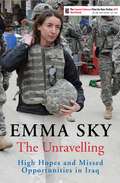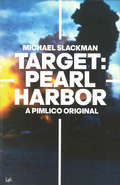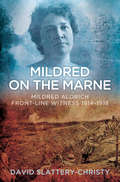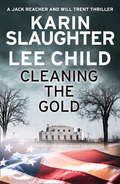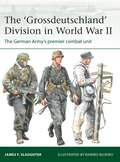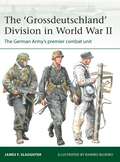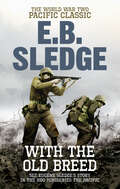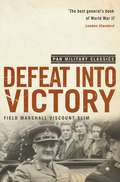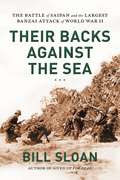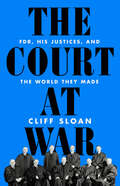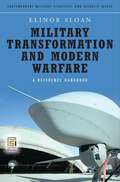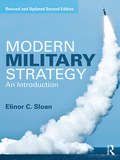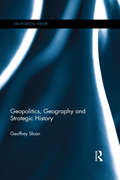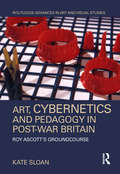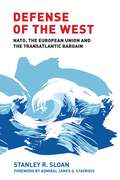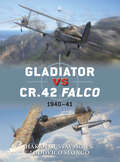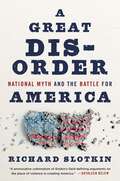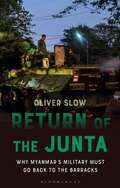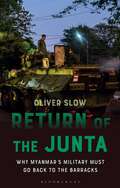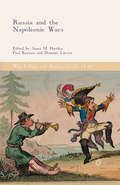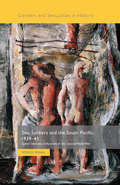- Table View
- List View
The Unravelling: High Hopes and Missed Opportunities in Iraq
by Emma SkySHORTLISTED FOR THE ORWELL PRIZE 2016SHORTLISTED FOR THE SAMUEL JOHNSON PRIZE 2015Emma Sky was working for the British Council during the invasion of Iraq, when the ad went around calling for volunteers. Appalled at what she saw as a wrongful war, she signed up, expecting to be gone for months. Instead, her time in Iraq spanned a decade, and became a personal odyssey so unlikely that it could be a work of fiction. Quickly made civilian representative of the CPA in Kirkuk, and then political advisor to General Odierno, Sky became valued for her outspoken voice and the unique perspective she offered as an outsider. In her intimate, clear-eyed memoir of her time in Iraq, a young British woman among the men of the US military, Emma Sky provides a vivid portrait of this most controversial of interventions, exploring how and why the Iraq project failed.
Target: Pearl Harbor
by Michael SlackmanIn this extremely vivid account of the Pearl Harbor attack, Michael Slackman takes us right through the course of events. He starts by scrutinising the circumstances and decisions that prompted the attack and left the United States so unprepared, looking at Japan's objectives in South-East Asia, the political and economic developments which drew them into conflict, and at American strategic thought.The core of the book, however, concerns the events of 7 December 1941 itself, as seen through the eyes of both Japanese and American participants, Slackman recounts the experiences of these people and included stories and anecdotes from over a hundred interviews with survivors. His use of contemporary documents and firsthand personal accounts presents us with a remarkably intense and detailed telling of the attack. He goes on to examine the aftermath of Pearl Harbour and all its consequences. While it was a short-term success for the Japanese, the attack led to the end of American isolationism and changed the course of the war.With its central focus on the unfolding human drama and its succinct analyses of the events before and after the attack, Target: Pearl Harbor is an absorbing and detailed account of one of the most significant days of the Second World War.
Mildred on the Marne: Mildred Aldrich, Front-line Witness 1914-1918
by David Slattery-ChristyThis is the story of 61-year-old Mildred Aldrich and her experiences of the Great War. She retired to a small hill-top house called La Creste in February 1914, with views across the Marne river and valley, little realising she would become embroiled in the first major battle of the war. In spite of the danger she decided to stay and help the British soldiers. Her home was for a few days behind German lines but the British pushed the Germans into retreat and La Creste remained in British territory for the duration. They entrenched in the Marne Valley and Mildred's 'beloved panorama' as she described the view, turned into the valley of horror and death. Informed by journalist Mildred's unpublished journals and voices of those serving in the BEF, along with historical military background, this book examines events from the unique perspective of a remarkable woman who lived through them.
Cleaning the Gold: A Jack Reacher And Will Trent Short Story
by Karin Slaughter Lee ChildGet ready for a turbo-charged short read (80 pages) from two of the world’s biggest thriller writers – Karin Slaughter and Lee Child.
The 'Grossdeutschland' Division in World War II: The German Army's premier combat unit (Elite #255)
by Professor James F. SlaughterInvestigates the history and evolving appearance of the 'Grossdeutschland' Division, the German Army's premier combat unit during World War II. Featuring eight pages of original artwork and carefully chosen photographs depicting personalities, uniforms, insignia and personal equipment, this is the absorbing story of the German Army's elite 'fire brigade' during 1939–45. The unit began its life as an elite guard detachment; expanded to regimental size in 1939, it saw action in France in 1940 and Yugoslavia in 1941 before participating in the Axis invasion of the Soviet Union. Reinforced to divisional status, 'Grossdeutschland' fought on the Eastern Front in 1942–44, notably at Rzhev in late 1942 and Kharkov in early 1943. Refitted and redesignated a Panzergrenadier-Division, 'Grossdeutschland' played a key role in the battle of Kursk in July 1943, before acting as the Wehrmacht's 'fire brigade' in 1943–44. In late 1944, 'Grossdeutschland' was expanded to Panzerkorps status, with Panzergrenadier-Division 'Brandenburg' also taking the field. Further units joined the order of battle, the Führerbegleit-Brigade fighting in the Ardennes in 1944–45 before also being redesignated a division. All of these campaigns are covered in this book, which charts the evolving appearance of this elite formation over nearly six years of brutal warfare.
The 'Grossdeutschland' Division in World War II: The German Army's premier combat unit (Elite #255)
by Professor James F. SlaughterInvestigates the history and evolving appearance of the 'Grossdeutschland' Division, the German Army's premier combat unit during World War II. Featuring eight pages of original artwork and carefully chosen photographs depicting personalities, uniforms, insignia and personal equipment, this is the absorbing story of the German Army's elite 'fire brigade' during 1939–45. The unit began its life as an elite guard detachment; expanded to regimental size in 1939, it saw action in France in 1940 and Yugoslavia in 1941 before participating in the Axis invasion of the Soviet Union. Reinforced to divisional status, 'Grossdeutschland' fought on the Eastern Front in 1942–44, notably at Rzhev in late 1942 and Kharkov in early 1943. Refitted and redesignated a Panzergrenadier-Division, 'Grossdeutschland' played a key role in the battle of Kursk in July 1943, before acting as the Wehrmacht's 'fire brigade' in 1943–44. In late 1944, 'Grossdeutschland' was expanded to Panzerkorps status, with Panzergrenadier-Division 'Brandenburg' also taking the field. Further units joined the order of battle, the Führerbegleit-Brigade fighting in the Ardennes in 1944–45 before also being redesignated a division. All of these campaigns are covered in this book, which charts the evolving appearance of this elite formation over nearly six years of brutal warfare.
With the Old Breed: The World War Two Pacific Classic
by Eugene B SledgeThe inspiration behind the HBO series THE PACIFICThis was a brutish, primitive hatred, as characteristic of the horror of war in the Pacific as the palm trees and the islands...Landing on the beach at Peleliu in 1944 as a twenty-year-old new recruit to the US Marines, Eugene Sledge can only try desperately to survive. At Peleliu and Okinawa - two of the fiercest and filthiest Pacific battles of WWII - he witnesses the dehumanising brutality displayed by both sides and the animal hatred that each soldier has for his enemy.During temporary lapses in the fighting, conditions on the islands mean that the Marines often can't wash, stay dry, dig latrines, or even find time to eat. Suffering from constant fear, fatigue, and filth, the struggle of simply living in a combat zone is utterly debilitating.Yet despite horrendous conditions Sledge finds time to keep notes that he would later turn into a book. Described as one of the finest memoirs to emerge from any war, With the Old Breed tells with compassion and honesty of the cruelty, bravery and deaths of the men he fought alongside, and of his own journey from patriotic innocence to battle-scarred veteran.'Eugene Sledge became more than a legend with his memoir, With The Old Breed. He became a chronicler, a historian, a storyteller who turns the extremes of the war in the Pacific - the terror, the camaraderie, the banal and the extraordinary - into terms we mortals can grasp' Tom Hanks
Defeat Into Victory: (Pan Military Classics Series) (The\great Commanders Ser.)
by William SlimField Marshal William Slim stands alongside Montgomery as the outstanding British field commander of World War II. Defeat Into Victory is his classic account of the Burma campaign: a story of retreat, attrition and final hard-fought victory over the Japanese. Told by a commander always at the centre of events, this is a narrative which captures both the high drama and the harsh reality of war.
Their Backs Against the Sea: The Battle of Saipan and the Largest Banzai Attack of World War II
by Bill SloanIn the midst of the largest banzai attack of the war, US Army Lt. Col. William O'Brien, grievously wounded and out of ammunition, grabbed a sabre from a fallen Japanese soldier and flailed away at a small army of assailants, screaming to his men, "Don't give them a damn inch!" When his body was recovered the next day, thirty dead enemies were piled around him.The Battle of Saipan lasted twenty-five hellish days in the summer of 1944, and the stakes couldn't have been higher. If Japan lost possession of the island, all hope for victory would be lost. For the Americans, its capture would result in secure air bases for the new B-29s that would put them within striking distance of the Japanese homeland. The outcome of the war in the Pacific lay in the balance.In this gritty, vivid narrative, award-winning author Bill Sloan fuses fresh interviews, oral and unit histories, and unpublished accounts to describe one of the war's bloodiest and most overlooked battles of the Pacific theater. Combining grunt's-view grit with big picture panorama (and one of the ugliest inter-service controversies of the war), Their Backs against the Sea is the definitive dramatic story of this epic battle--and an inspiring chronicle of some of the greatest acts of valor in American military history.
Their Backs Against the Sea: The Battle of Saipan and the Largest Banzai Attack of World War II
by Bill SloanIn the midst of the largest banzai attack of the war, US Army Lt. Col. William O'Brien, grievously wounded and out of ammunition, grabbed a sabre from a fallen Japanese soldier and flailed away at a small army of assailants, screaming to his men, "Don't give them a damn inch!" When his body was recovered the next day, thirty dead enemies were piled around him. The Battle of Saipan lasted twenty-five hellish days in the summer of 1944, and the stakes couldn't have been higher. If Japan lost possession of the island, all hope for victory would be lost. For the Americans, its capture would result in secure air bases for the new B-29s that would put them within striking distance of the Japanese homeland. The outcome of the war in the Pacific lay in the balance. In this gritty, vivid narrative, award-winning author Bill Sloan fuses fresh interviews, oral and unit histories, and unpublished accounts to describe one of the war's bloodiest and most overlooked battles of the Pacific theater. Combining grunt's-view grit with big picture panorama (and one of the ugliest inter-service controversies of the war), Their Backs against the Sea is the definitive dramatic story of this epic battle -- and an inspiring chronicle of some of the greatest acts of valor in American military history.
The Court at War: FDR, His Justices, and the World They Made
by Cliff SloanThe inside story of how one president forever altered the most powerful legal institution in the country—with consequences that endure today By the summer of 1941, in the ninth year of his presidency, Franklin Roosevelt had molded his Court. He had appointed seven of the nine justices—the most by any president except George Washington—and handpicked the chief justice. But the wartime Roosevelt Court had two faces. One was bold and progressive, the other supine and abject, cowed by the charisma of the revered president. The Court at War explores this pivotal period. It provides a cast of unforgettable characters in the justices—from the mercurial, Vienna-born intellectual Felix Frankfurter to the Alabama populist Hugo Black; from the western prodigy William O. Douglas, FDR&’s initial pick to be his running mate in 1944, to Roosevelt&’s former attorney general and Nuremberg prosecutor Robert Jackson. The justices&’ shameless capitulation and unwillingness to cross their beloved president highlight the dangers of an unseemly closeness between Supreme Court justices and their political patrons. But the FDR Court&’s finest moments also provided a robust defense of individual rights, rights the current Court has put in jeopardy. Sloan&’s intimate portrait is a vivid, instructive tale for modern times.
Military Transformation and Modern Warfare: A Reference Handbook (Contemporary Military, Strategic, and Security Issues)
by Elinor SloanMilitary transformation can be understood as comprising three overlapping and sometimes competing layers—the conventional-force dominated revolution in military affairs, a more recent irregular warfare emphasis, and a wider dimension including homeland defense, space and nuclear policy. The Western world is currently focusing its attention on transformation's middle layer, while China and Russia are focusing on the RMA and transformation's wider aspects. This dynamic indicates the United States and its allies should continue to prepare for the full range of conflicts.This book establishes the meaning of military transformation, assesses the manner in which certain countries are transforming their military forces, discusses the relevancy of transformation efforts to modern conflict and, in drawing out the key areas of emphasis on the part of various countries, provides a window on the future global security environment. It is divided into seven chapters, plus a conclusion. The first chapter focuses on the meaning of military transformation, establishing a framework through which national militaries can be examined. This comprises transformation's revolution in military affairs components, its newer special operations forces, counterinsurgency, and stabilization and reconstruction aspects, and its wider homeland defense, space and deterrence dimensions. The book devotes two chapters to the United States and one each to China, Russia, and NATO. It also has a chapter that looks individually at each of Australia, Britain, Canada, France and Germany. An assessment of the relevancy of force transformation to modern warfare is integrated into the discussion of what transformation means, how the United States is responding, and the concluding chapter. The book contains a biographical sketch of Andrew Marshall, Andrew Krepinevich, William Owens, Arthur Cebrowski, Donald Rumsfeld, and Thomas Barnett, all of whom have been involved in some aspect of military transformation.
Modern Military Strategy: An Introduction
by Elinor C. SloanThis textbook provides a comprehensive introduction to post-Cold War military theory for students of strategic studies. This second edition has been fully revised and updated, including a new chapter on peacekeeping, and examines contemporary strategic thought on the conduct of war in the sea, land, air, nuclear, space and cyber domains, as well as irregular warfare. Each chapter identifies contemporary strategic thinkers in a particular area, examines strategic thought through the lens of identifiable themes, and discusses the ideas of classical strategists to provide historical context. Examples of the link between the use of military force and the pursuit of political objectives are presented, such as airpower against ISIS and in Libya, counterinsurgency in Afghanistan and Iraq, counter-piracy operations off the coast of Africa, and the Stuxnet virus in Iran. The chapters identify trends, statements and principles that indicate how military power can best be employed to effect political ends, while the conclusion paints an overall picture of the relationship between classic and contemporary strategic thinking within each warfare domain. This book will be essential reading for students of strategic studies, war studies and military history, and is highly recommended for students of security studies and international relations in general.
Modern Military Strategy: An Introduction
by Elinor C. SloanThis textbook provides a comprehensive introduction to post-Cold War military theory for students of strategic studies. This second edition has been fully revised and updated, including a new chapter on peacekeeping, and examines contemporary strategic thought on the conduct of war in the sea, land, air, nuclear, space and cyber domains, as well as irregular warfare. Each chapter identifies contemporary strategic thinkers in a particular area, examines strategic thought through the lens of identifiable themes, and discusses the ideas of classical strategists to provide historical context. Examples of the link between the use of military force and the pursuit of political objectives are presented, such as airpower against ISIS and in Libya, counterinsurgency in Afghanistan and Iraq, counter-piracy operations off the coast of Africa, and the Stuxnet virus in Iran. The chapters identify trends, statements and principles that indicate how military power can best be employed to effect political ends, while the conclusion paints an overall picture of the relationship between classic and contemporary strategic thinking within each warfare domain. This book will be essential reading for students of strategic studies, war studies and military history, and is highly recommended for students of security studies and international relations in general.
Geopolitics, Geography and Strategic History (Geopolitical Theory)
by Geoffrey SloanThis volume examines geopolitics by looking at the interaction between geography, strategy and history. This book addresses three interrelated questions: why does the geographical scope of political objectives and subsequent strategy of states change? How do these changes occur? Over what period of time do these changes occur? The theories of Sir Halford Mackinder and Nicholas Spykman are examined in order to provide an analytical narrative for five case studies, four historical and one contemporary. Taken together they offer the prospect of converting descriptions of historical change into analytic explanations, thereby highlighting the importance of a number of commonly overlooked variables. In addition, the case studies will illuminate the challenges that states face when attempting to change the scope of their foreign policy and geo-strategy in response to shifts in the geopolitical reality. This book breaks new ground in seeking to provide a way to understand why and how the geographical scope of political objectives and subsequent strategy both expands and contracts. This book will be of much interest to students of geopolitics, strategic studies, military history, and international relations.
Geopolitics, Geography and Strategic History (Geopolitical Theory)
by Geoffrey SloanThis volume examines geopolitics by looking at the interaction between geography, strategy and history. This book addresses three interrelated questions: why does the geographical scope of political objectives and subsequent strategy of states change? How do these changes occur? Over what period of time do these changes occur? The theories of Sir Halford Mackinder and Nicholas Spykman are examined in order to provide an analytical narrative for five case studies, four historical and one contemporary. Taken together they offer the prospect of converting descriptions of historical change into analytic explanations, thereby highlighting the importance of a number of commonly overlooked variables. In addition, the case studies will illuminate the challenges that states face when attempting to change the scope of their foreign policy and geo-strategy in response to shifts in the geopolitical reality. This book breaks new ground in seeking to provide a way to understand why and how the geographical scope of political objectives and subsequent strategy both expands and contracts. This book will be of much interest to students of geopolitics, strategic studies, military history, and international relations.
Art, Cybernetics and Pedagogy in Post-War Britain: Roy Ascott’s Groundcourse (Routledge Advances in Art and Visual Studies)
by Kate SloanThis is the first full-length study about the British artist Roy Ascott, one of the first cybernetic artists, with a career spanning seven decades to date. The book focuses on his early career, exploring the evolution of his early interests in communication in the context of the rich overlaps between art, science and engineering in Britain during the 1950s and 1960s. The first part of the book looks at Ascott’s training and early work. The second park looks solely at Groundcourse, Ascott’s extraordinary pedagogical model for visual arts and cybernetics which used an integrative and systems-based model, drawing in behaviourism, analogue machines, performance and games. Using hitherto unpublished photographs and documents, this book will establish a more prominent place for cybernetics in post-war British art.
Art, Cybernetics and Pedagogy in Post-War Britain: Roy Ascott’s Groundcourse (Routledge Advances in Art and Visual Studies)
by Kate SloanThis is the first full-length study about the British artist Roy Ascott, one of the first cybernetic artists, with a career spanning seven decades to date. The book focuses on his early career, exploring the evolution of his early interests in communication in the context of the rich overlaps between art, science and engineering in Britain during the 1950s and 1960s. The first part of the book looks at Ascott’s training and early work. The second park looks solely at Groundcourse, Ascott’s extraordinary pedagogical model for visual arts and cybernetics which used an integrative and systems-based model, drawing in behaviourism, analogue machines, performance and games. Using hitherto unpublished photographs and documents, this book will establish a more prominent place for cybernetics in post-war British art.
Defense of the West: NATO, the European Union and the transatlantic bargain (Manchester University Press Ser.)
by Stanley SloanThis accessible and up-to-date analysis of transatlantic relations is based on more than forty years of experience working for the US Congress and the intelligence community.
Gladiator vs CR.42 Falco: 1940–41 (Duel #47)
by Ludovico Slongo Håkan GustavssonBoth the Gloster Gladiator and the Fiat CR.42 Falco represented the peak in the development of the biplane fighter, which could trace its lineage back to World War I. However, by the time both aircraft entered service in the late 1930s, they were already obsolete. Nevertheless, they gave sterling service on all fronts in the Mediterranean and Africa in 1940–41. Indeed, the CR.42 was the Regia Aeronautica's staple fighter in both North and East Africa, Greece and over Malta in 1940–41, during which time its pilots routinely fought British and Commonwealth squadrons equipped in the main with Gladiator biplanes. Some bitter dogfights were fought between these two types as the Allies attempted to gain control of the skies over North Africa, Greece and East Africa. Both types were flown in the main by highly experienced pre-war pilots, and this in turn made for some closely fought engagements. The first known combat between the CR.42 and the Gladiator took place on 14 June 1940 over North Africa and the last engagement between the two types occurred on 24 October 1941 over the East African front.
A Great Disorder: National Myth and the Battle for America
by Richard SlotkinAs culture wars pit us against each other, A Great Disorder looks to the myths that have shaped American identity and reveals how they have brought us to the brink of an existential crisis.Red America and Blue America are so divided they could be two different countries, with wildly diverging views of why government exists and who counts as American. Their ideologies are grounded in different versions of American history, endorsing irreconcilable visions of patriotism and national identity.A Great Disorder is a bold, urgent work that helps us make sense of today’s culture wars through a brilliant reconsideration of America’s foundational myths and their use in contemporary politics. Famous for his trilogy on the Myth of the Frontier, Richard Slotkin identifies five myths, born of different eras, that have shaped our conception of what it means to be American: the myths of the Frontier, the Founding, the Civil War (which he breaks into two opposing camps, Emancipation and the Lost Cause), and the Good War, embodied by the multiethnic platoon fighting for freedom. His argument is that while Trump and his MAGA followers have played up a frontier-inspired hostility to the federal government and rallied around Confederate symbols to champion a racially exclusive definition of American nationality, Blue America, taking its cue from the protest movements of the 1960s, envisions a limitlessly pluralistic country in which the federal government is the ultimate enforcer of rights and opportunities. American history—and the foundations of our democracy—have become a battleground. It is not clear at this time which vision will prevail.
Return of the Junta: Why Myanmar’s Military Must Go Back to the Barracks (Asian Arguments)
by Oliver SlowOn the first day of February 2021, Myanmar's military grabbed power in a coup d'etat, ending a decade of reforms that were supposed to break the shackles of military rule in Myanmar. Protests across the country were met with a brutal crackdown that shocked the world but were a familiar response from an institution that has ruled the country with violence and terror for decades. Return of the Junta is a detailed account of the ways that Myanmar's military – the Tamatdaw - has maintained control over its people despite a decade of supposed reform. In this detailed account, drawing on first-hand accounts from activists, jouralists and politicians, Oliver Slow explores the measures the military has used to keep hold of power and the motivations of those now rising up against its rule. The book asks the question: what needs to be done to remove the military from power in Myanmar once and for all?
Return of the Junta: Why Myanmar’s Military Must Go Back to the Barracks (Asian Arguments)
by Oliver SlowOn the first day of February 2021, Myanmar's military grabbed power in a coup d'etat, ending a decade of reforms that were supposed to break the shackles of military rule in Myanmar. Protests across the country were met with a brutal crackdown that shocked the world but were a familiar response from an institution that has ruled the country with violence and terror for decades. Return of the Junta is a detailed account of the ways that Myanmar's military – the Tamatdaw - has maintained control over its people despite a decade of supposed reform. In this detailed account, drawing on first-hand accounts from activists, jouralists and politicians, Oliver Slow explores the measures the military has used to keep hold of power and the motivations of those now rising up against its rule. The book asks the question: what needs to be done to remove the military from power in Myanmar once and for all?
Russia and the Napoleonic Wars (War, Culture and Society, 1750-1850)
by Yorick SmaalRussia played a fundamental role in the outcome of Napoleonic Wars; the wars also had an impact on almost every area of Russian life. Russia and the Napoleonic Wars brings together significant and new research from Russian and non-Russian historians and their work demonstrates the importance of this period both for Russia and for all of Europe.
Sex, Soldiers and the South Pacific, 1939-45: Queer Identities in Australia in the Second World War (Genders and Sexualities in History)
by Yorick SmaalSex, Soldiers and the South Pacific, 1939-45 explores the queer dynamics of war across Australia and forward bases in the south seas. It examines relationships involving Allied servicemen, civilians and between the legal and medical fraternities that sought to regulate and contain expressions of homosex in and out of the forces.
